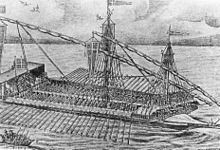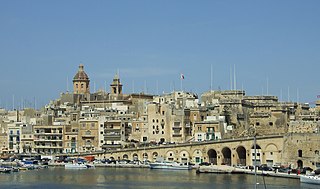
Birgu, also known by its title Città Vittoriosa, is an old fortified city on the south side of the Grand Harbour in the South Eastern Region of Malta. The city occupies a promontory of land with Fort Saint Angelo at its head and the city of Cospicua at its base. Birgu is ideally situated for safe anchorage, and over time it has developed a very long history with maritime, mercantile and military activities.

The Third Battle of the Dardanelles in the Fifth Ottoman-Venetian War took place on 26 and 27 June 1656 inside the Dardanelles Strait. The battle was a clear victory for Venice and the Knights Hospitaller over the Ottoman Empire, although their commander, Lorenzo Marcello, was killed on the first day.

The Great Siege of Malta occurred in 1565 when the Ottoman Empire attempted to conquer the island of Malta, then held by the Knights Hospitaller. The siege lasted nearly four months, from 18 May to 13 September 1565.
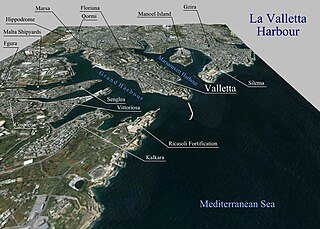
The Grand Harbour, also known as the Port of Valletta, is a natural harbour on the island of Malta. It has been substantially modified over the years with extensive docks, wharves, and fortifications.

Fra' Claude de la Sengle was the 48th Grand Master of the Order of Malta, from 1553 his death. His successor was Fra' Jean Parisot de Valette.
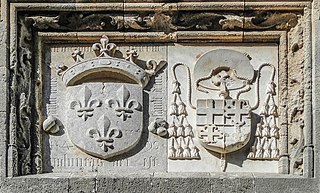
A langue or tongue was an administrative division of the Knights Hospitaller between 1319 and 1798. The term referred to a rough ethno-linguistic division of the geographical distribution of the Order's members and possessions. Each langue was subdivided into Priories or Grand Priories, Bailiwicks and Commanderies. Each langue had an auberge as its headquarters, some of which still survive in Rhodes, Birgu and Valletta.

Fra Gregorio Carafa was a nobleman from the House of Carafa and the 61st Grand Master of the Order of Saint John, from 1680 to his death in 1690.

The Order of Knights of the Hospital of Saint John of Jerusalem, commonly known as the Knights Hospitaller, was a medieval and early modern Catholic military order. It was headquartered in the Kingdom of Jerusalem until 1291, on the island of Rhodes from 1310 until 1522, in Malta from 1530 until 1798 and at Saint Petersburg from 1799 until 1801. Today several organizations continue the Hospitaller tradition, specifically the mutually recognized orders of St. John, which are the Sovereign Military Order of Malta, the Most Venerable Order of the Hospital of Saint John, the Bailiwick of Brandenburg of the Chivalric Order of Saint John, the Order of Saint John in the Netherlands, and the Order of Saint John in Sweden.

HMSAthenienne was a 64-gun third-rate ship of the line of the Royal Navy. She was the former Maltese ship San Giovanni, which the French captured on the stocks in 1798 and launched and commissioned as Athénien. The Royal Navy captured her at or prior to the surrender of Valletta, on 4 September 1800, and took her into service as Athenienne. She was wrecked near Sicily, with great loss of life, in 1806.

The Malta Maritime Museum is a maritime museum in Birgu, Malta. It is housed in the former Royal Naval Bakery, which was built in the 1840s as the main bakery for the Mediterranean Fleet. The museum has a collection of over 20,000 artifacts, and it is the largest museum on the island.

The siege of Malta, also known as the siege of Valletta or the French blockade, was a two-year siege and blockade of the French garrison in Valletta and the Three Cities, the largest settlements and main port on the Mediterranean island of Malta, between 1798 and 1800. Malta had been captured by a French expeditionary force during the Mediterranean campaign of 1798, and garrisoned with 3,000 soldiers under the command of Claude-Henri Belgrand de Vaubois. After the British Royal Navy destroyed the French Mediterranean Fleet at the Battle of the Nile on 1 August 1798, the British were able to initiate a blockade of Malta, assisted by an uprising among the native Maltese population against French rule. After its retreat to Valletta, the French garrison faced severe food shortages, exacerbated by the effectiveness of the British blockade. Although small quantities of supplies arrived in early 1799, there was no further traffic until early 1800, by which time starvation and disease were having a disastrous effect on health, morale, and combat capability of the French troops.

Hospitaller Malta, known within Maltese history as the Knights' Period, existed between 1530 and 1798 when the Mediterranean islands of Malta and Gozo were ruled by the Order of St. John of Jerusalem. The polity was formally a vassal state of the Kingdom of Sicily, and it came into being when Emperor Charles V granted the islands as well as the city of Tripoli in modern Libya to the Order, following the latter's loss of Rhodes in 1522. Hospitaller Tripoli was lost to the Ottoman Empire in 1551, but an Ottoman attempt to take Malta in 1565 failed.
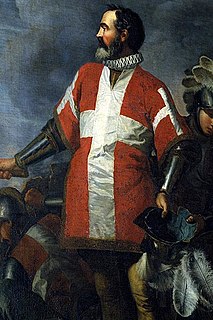
Fra' Jean "Parisot" de la Valette was a French nobleman and 49th Grand Master of the Order of Malta, from 21 August 1557 to his death in 1568. As a Knight Hospitaller, joining the order in the Langue de Provence, he fought with distinction against the Turks at Rhodes. As Grand Master, Valette became the Order's hero and most illustrious leader, commanding the resistance against the Ottomans at the Great Siege of Malta in 1565, sometimes regarded as one of the greatest sieges of all time.

The fortifications of Malta consist of a number of walled cities, citadels, forts, towers, batteries, redoubts, entrenchments and pillboxes. The fortifications were built over thousands of years, from around 1450 BC to the mid-20th century, and they are a result of the Maltese islands' strategic position and natural harbours, which have made them very desirable for various powers.

The fortifications of Valletta are a series of defensive walls and other fortifications which surround Valletta, the capital city of Malta. The first fortification to be built was Fort Saint Elmo in 1552, but the fortifications of the city proper began to be built in 1566 when it was founded by Grand Master Jean de Valette. Modifications were made throughout the following centuries, with the last major addition being Fort Lascaris which was completed in 1856. Most of the fortifications remain largely intact today.

Slavery in Malta existed and was recognised from classical antiquity until the early modern period, as was the case in many countries around the Mediterranean Sea. The system reached its apex under Hospitaller rule, when it took on unprecedented proportions, largely to provide galley slaves for the galleys of the Order, as well as other Christian countries. Commerce raids, which were the backbone of the Knights' economic military system helped to maintain this system, partly through creating the demand for slaves to maintain the military fleet, but also due to the influx of Muslim prisoners when battles were won. Thus Malta became the hub of slavery in Christian Europe. Slavery was abolished in Malta by Napoléon Bonaparte during his invasion of the Maltese archipelago on 16 June 1798.

The French invasion of Malta was the successful invasion of the islands of Malta and Gozo, then ruled by the Order of St. John, by the French First Republic led by Napoleon Bonaparte in June 1798 as part of the Mediterranean campaign of the French Revolutionary Wars.

The Slaves' Prison officially known as the Grand Prison and colloquially as the bagnio, was a prison in Valletta, Malta. It was established in the late 16th century, and remained in use as a prison throughout the 17th and 18th centuries. It was subsequently used as a naval hospital, a school and an examination hall. It was bombed in World War II, and the ruins were demolished to make way for a block of flats.

The Forni della Signoria was a bakehouse in Valletta, Malta. It was constructed in the late 16th century by the Order of St John, and it consisted of a number of bakeries which produced bread for the inhabitants of Valletta and the surrounding area, as well as for the Order's garrison and navy.

The 1592–1593 Malta plague epidemic was a major outbreak of plague on the island of Malta, then ruled by the Order of St John. It occurred in three waves between June 1592 and September 1593, during the second plague pandemic, and it resulted in approximately 3000 deaths, which amounted to about 11% of the population. The disease was imported to Malta by Tuscan galleys that had captured vessels from Alexandria. In 1593, the Order requested assistance from Sicily to deal with the epidemic, and the measures taken were effective in containing plague.






